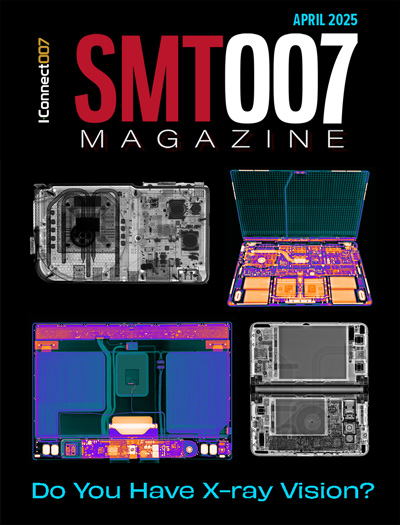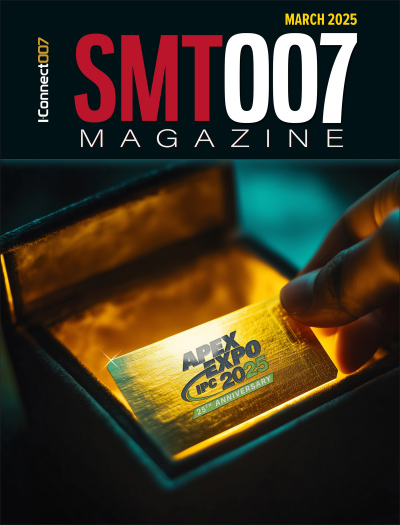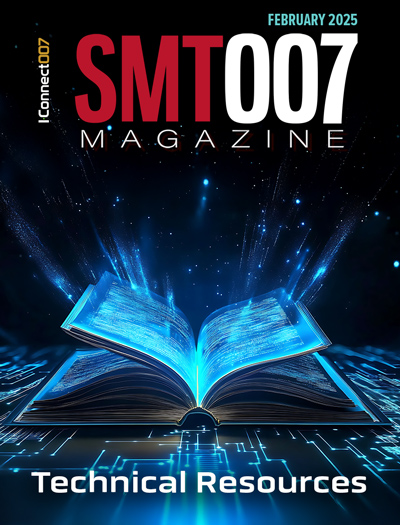-

- News
- Books
Featured Books
- smt007 Magazine
Latest Issues
Current Issue
Do You Have X-ray Vision?
Has X-ray’s time finally come in electronics manufacturing? Join us in this issue of SMT007 Magazine, where we answer this question and others to bring more efficiency to your bottom line.

IPC APEX EXPO 2025: A Preview
It’s that time again. If you’re going to Anaheim for IPC APEX EXPO 2025, we’ll see you there. In the meantime, consider this issue of SMT007 Magazine to be your golden ticket to planning the show.

Technical Resources
Key industry organizations–all with knowledge sharing as a part of their mission–share their technical repositories in this issue of SMT007 Magazine. Where can you find information critical to your work? Odds are, right here.
- Articles
- Columns
Search Console
- Links
- Media kit
||| MENU - smt007 Magazine
Line Buffering and Productivity Gains
December 31, 1969 |Estimated reading time: 4 minutes
Henry Ford implemented an assembly line more than 90 years ago. Productivity gains of more efficient manufacturing processes occur in small steps of continuous improvement. This article outlines some benefits that line buffering can provide during the placement process.
By Tom Foley and Ian Rawles
More than 90 years ago, Henry Ford implemented the first continuous flow, progressive assembly line - with the desire to mass-produce an automobile that virtually everyone in America could afford. Ford initially applied the assembly line concept to the assembly of magnetic flywheels, and reduced the assembly time from 20 minutes to 5 minutes. Ford later changed the automobile chassis assembly process from batch to continuous flow; and with continuous improvement, assembly times were ultimately reduced to 93 man minutes. Soon after, Model T Fords were dotting the American landscape.
 Figure 1. Simple assembly line consisting of five operators.
Figure 1. Simple assembly line consisting of five operators.
Normally, productivity gains through more efficient manufacturing processes occur in small steps of continuous improvement. Line buffering is a key example of this - the classical manual assembly line. Figure 1 shows a simple assembly line consisting of five operators, each assigned to assemble one-fifth of a widget. In this example, there are no buffer spaces between operators. If this line is to achieve maximum output, each operator must finish his work cycle at exactly the same time, and release the widget downstream to the next operator in the line simultaneously. However, a perfectly-balanced line scenario such as this is rarely possible to achieve because of random interruptions and normal cycle-time variability. Figure 2 shows the same line with a buffer location for one widget between operators. The buffers allow the production line to breathe, enabling normal differences in cycle time between operators. When one operator overruns the target cycle time by a few seconds, this will not affect the production flow up and downstream. Other operators can release their widgets into the buffer location and begin assembling the next widget. Depending on the line concept and cycle time, productivity gains of 5-15% can be realized when implementing a one-product buffer between operators in a manual assembly line.
 Figure 2. Assembly line with a buffer location for one widget between operators.
Figure 2. Assembly line with a buffer location for one widget between operators.
Is this level of increased productivity possible by using buffers in automated production lines? To quantify this, a simulation study of the SMT placement process was conducted. An identical SMT line was simulated twice - with and without buffering between process zones (placement zones).
 Figure 3. SMT line with eight process zones.
Figure 3. SMT line with eight process zones.
Figure 3 illustrates an SMT line with eight process zones. A process zone is defined as the location in which a machine places components on the PCB. Between each process zone is space in the conveyor to buffer one PCB. Figure 4 also shows eight process zones, but without buffers in between them. Both lines are designed to produce a finished board every 20 seconds, or 180 boards per hour provided the line can run at 100% efficiency.
 Figure 4. SMT line with eight process zones without buffers in between them.
Figure 4. SMT line with eight process zones without buffers in between them.
To simulate a realistic production environment, equal interruptions were introduced to both lines in the simulation model. When looking at the SMT placement process, there are two types of line interruptions or stoppages that occur at random times.
The first is automatic-assist interruptions, which are defined as interruptions from which the placement machine can recover without operator intervention. Component re-pick (retry) in the case of a mis-pick, and vision-rejected components are typical examples of automatic assists. These interruptions occur randomly during production. Therefore, we modeled this to occur one time every 25-50 boards, adding two seconds to the cycle time.
The second is manual interruptions, which are defined as an interruptions that stop the placement machine until the operator resolves the issue and restarts. Feeder jams, empty component reels, and multiple fiducial-read errors are examples of manual interruptions. Manual interruptions were modeled to occur randomly every 80-160 boards. The time to recover from manual interruptions was also random at 30-150 seconds.
Simulating a full-day production for a three-shift operation yielded some interesting results. In a 24-hour period, the line with single-board buffers between placement modules (Figure 3) produced 3,620 boards, while the line without buffers (Figure 4) produced 3,351 boards. Line A out-produces Line B by 269 boards, amounting to a 7.5% productivity gain. Line A (with buffers) runs at 84% efficiency (3620/4320=0.837), while Line B operates at 77.5% efficiency (3351/4320= 0.775). The line with buffers runs 84% of the time, while the line without buffers runs 77% of the time. Automatic- and manual-assist interruptions lead to a higher percentage of line-blocked and line-idle (starved) conditions for the line without buffers. When viewed for a year, additional output offered from the line with buffers was compelling.
Simulation analysis shows that normal line interruptions and stoppages have a greater negative effect on the line without buffers. Interruptions in Line B quickly create a back-up of PCBs upstream, and a starved condition downstream. When one placement zone is interrupted, the other seven also become nonproductive quickly. Line A outperforms Line B because a single-board buffer between process zones lessens the impact of normal line interruptions, enabling all zones to run efficiently.
Conclusion
In manufacturing, cost savings and efficiency gains rarely come in such large steps, as was the case with Henry Ford’s assembly line. Most often, productivity gains result from incremental steps of continuous improvement - focused on eliminating tasks that don’t add customer value. One should not overlook the significant productivity benefit that simple PCB buffering can provide during the placement process.
Tom Foley, product management, Siemens SE&A EA Electronics Assembly Systems, may be contacted at (770) 797-3475. Ian Rawles, key account manager, Siemens SE&A EA Electronics Assembly Systems, may be contacted at (770) 7797-3079.


